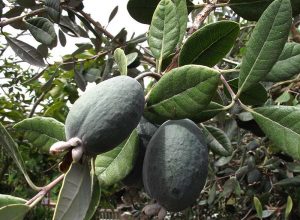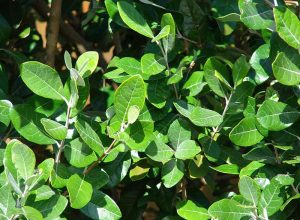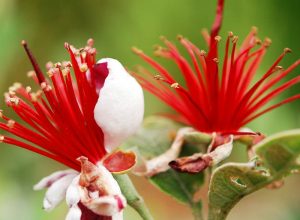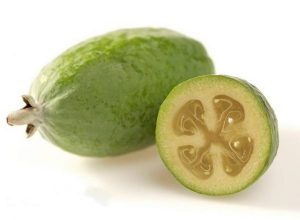Feijoa Sellowiana


Commonly known as Acca Sellowiana, this elegant evergreen shrub originating from the Northern heights of South America, is known to us a a tropical plant and used thanks to its beautiful flowers mainly ornamental use in gardens in the hot Meridian regions, it is only in recent years we realized that it can tolerate even the stiff winters in the North
And that the fruit it produces is exquisite and health giving-Medium sized shrubs, they are very long lasting, usually with multiple trunks of a light brown colour which reflects tones of silver, and which age tending to scale, slowly they reach a height of five metres and are of an equal width, with small to medium lovely, shiny green leaves in the picture above and silverfish in that below. It stands up to cold climates as does the more common olive and is very resistant to wind.
Its root system is somewhat superficial, and for this reason, even if enjoys full sun, it is advised to position it in half shade. Exposing it to direct sun rays could cause the plant to go into Summer retirement (an interruption of the plant’s growth) until the return of optimal conditions for vegetative process of the plant, this could cause an immediate loss of flowers and fruit and in more serious cases, de-foliage.
TERRAIN
For a rigorous vegetation it is opportune to plant the Feijoa Sellowiana in slightly acid soil, rich in organic substance, well drained but fresh to avoid it suffering during the Summer period, preferably loose it adapts well though to a compact soil. It sustains badly in stagnant after which, especially during the Summer period, this could bring about dangerous fungal attacks.


FLORA AND FRUIT
In early Spring, numerous medium sized flowers bloom at the top and along the branches, more often than not grouped together in three or four, with four large meaty petals, at first white and once fertilized take on a violet colour, with numerous coral red stamen, and terminate in showy yellow anthers which close into pistils.
They , are hermaphrodite flowers but having both male and female, it is advisable for better fruit bearing to position it near another Feijoa Selllowiana so as to encourage cross pollination. Flowering is followed by fruiting and the size of fruit is similar to that of an egg, opaque green and it gradually matures in Autumn. Obviously its maturing is influenced on how the season goes and also the region in which the plant grows. On complete maturation, the fruit spontaneously detaches from the plant: and this is the best time to appreciate its peculiar flavour.
Being a climatic fruit, that is it comes to full maturity even if detached from the plant, it is possible therefore to have a unique crop near to maturation, and as with the kiwi, they can be eaten slowly as they mature.
As with the fruit of the Mountain Banana, (see), the fruit has a very consistent peel which covers a white-ish creamy flesh with numerous tiny seeds which aren’t bothersome, in the open they can be conserved for a few days, in the fridge for a couple of weeks. They can be frozen but at the time of de-freezing they become very soft and difficult to display.
USE AND HEALTH PROPERTIES
Excellent when eaten fresh with a teaspoon having cut it in half, but is good peeled in fruit salads, or juiced, in jams or ice creams.
The flowers are also edible and you can use them in crunchy salads or eat them as sweets and with the dried leaves you can make a sweet and fragrant infused tea.
Of few calories, fifty for every 100 grams, the Feijoa fruit has a high potassium content and high vitamin C levels gives it strong antioxidant powers, whilst the high carbohydrate content makes it a good source of energy. It also Contains notable levels of iron and phosphorus. Highlighted is that the fact that it contains elevated antibacterial properties which fight against positive Gram bacteria and especially, negative Gram bacteria, improve capillary permeability, pumping more blood to the various tissue. The infusion you obtain from the leaves can be used as an antibiotic and a stimulant for the immune system.
But the element which mostly distinguishes the Feijoa is iodine, of which it contains notable quantity. This element is important to the human body the thyroid hormones depends on its availability of adequate quantities of iodine to function well.
Cosmetics also take advantage of the Feijoa’s properties; the flesh when blended and applied to the face has a notable hydrating effect.
PRUNING AND CULTIVATION
Long lasting plant, it doesn’t need any pruning the first years, so when the plant has taken shape, pruning will be needed just to correct the shape.
Like the Nanchino Cherry, once the Feijoa is stable, it doesn’t need manuring, these are suggested only when planting.
It’s a different story for watering: as the roots are so superficial and as it suffers from water stagnation, watering must be frequent, but taking care not to make the soil too damp; between watering make sure this has dried.
Fungi and parasites attacks are rare: in case of a very damp autumn climate, the fruit in the ripening phase can be hit by grey mold (Botrytis cinerea), while in hot summers possible attacks from woodlouse.
